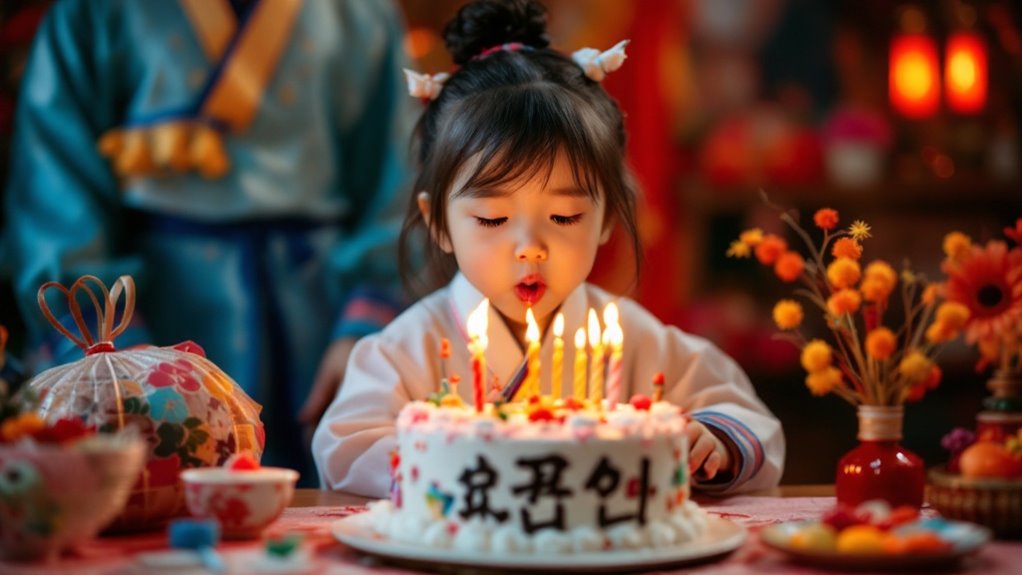Exploring half birthday traditions reveals a fascinating variety of customs around the globe. In Japan, families celebrate children’s growth with special meals, while Germany encourages sharing treats among classmates. Latin American cultures host lively “media fiestas” featuring music and dance. Scandinavian countries prefer outdoor gatherings to connect with nature. Each culture’s celebration highlights values of community and connection, making these milestones significant. Uncovering these traditions can inspire your own unique half birthday celebration experience.
Understanding Half Birthday Celebrations Globally

While you might think of birthdays as singular events celebrated once a year, half birthdays have emerged as an intriguing alternative in different cultures around the world, providing an opportunity to recognize milestones in a different light. Many families celebrate half birthdays to alleviate scheduling conflicts, especially when actual birthdays fall during busy seasons. Countries like Japan and those in Latin America welcome these occasions with gatherings that reflect cultural traditions. The rise of social media has further popularized these celebrations, allowing for creative themes and activities. Ultimately, half birthdays offer a fresh perspective on birthday traditions and special events, fostering connection and joy.
Unique Customs for Half Birthdays in Different Cultures
Half birthday celebrations aren’t just a modern trend; they’re steeped in unique customs that vary considerably across cultures. These half birthday traditions often serve to improve birthday celebrations and foster family connections. Here are a few notable customs:
Half birthday celebrations reflect diverse cultural customs, enhancing family connections and marking important milestones.
- In Japan, parents celebrate a half birthday to mark their child’s growth and development.
- Scandinavian countries host simple gatherings with outdoor activities, emphasizing community and nature.
- In Latin America, families enjoy a “media fiesta,” celebrating achievements with music and dance.
These diverse ways to celebrate a half birthday highlight the importance of milestones across different cultures and reinforce familial bonds.
How Half Birthdays Are Celebrated Across Continents

Celebrating half birthdays differs markedly across continents, reflecting the diverse cultural values and traditions that shape these observances. In the United States, simple gatherings and half cakes mark the occasion, while parts of Africa emphasize community celebrations for growth. Japan may not have specific traditions, but families often recognize milestones, including half birthdays. In Germany, schools allow children to bring treats for classmates if their birthdays fall during holidays. Meanwhile, in Australia and New Zealand, half birthdays are gaining traction, especially for summer-born kids, offering another opportunity to celebrate with friends.
| Country | Celebration Style |
|---|---|
| United States | Simple gatherings, half cakes |
| Africa | Community celebrations emphasizing growth |
| Japan | Milestone recognition throughout the year |
| Germany | School treats for classmates |
| Australia/New Zealand | Festive gatherings for summer births |
Special Activities and Traditions for Half Birthdays
With regard to marking half birthdays, many cultures incorporate unique activities and traditions that reflect their values and social customs. If you’re considering the idea of celebrating your birthday child’s half birthday, here are three engaging options:
- Germany: Your child might receive a special treat or gift, particularly if their actual birthday falls during summer vacation.
- Japan: Families gather for “Hanabira,” enjoying a meal together to reflect on the child’s growth over the past six months.
- Brazil: Celebrate with a “meio-aniversário” party, where friends and family come together for a festive meal, recognizing your child’s development.
The Significance of Half Birthdays in Various Societies

Half birthdays hold diverse meanings across different cultures, serving as a unique way to celebrate growth, especially for children whose birthdays fall during school breaks. In certain regions, families create distinct customs around these occasions, transforming them into opportunities for bonding through shared meals and activities that reflect their cultural heritage. Furthermore, communities that may not prioritize traditional birthday celebrations often see half birthdays as a relaxed substitute, allowing for joyful gatherings without the pressure of large-scale festivities.
Cultural Celebrations and Customs
While many people may view birthdays as singular annual events, the concept of half birthdays has gained traction in different cultures, reflecting unique customs and significance. Here are some notable cultural celebrations around half birthdays:
- In Japan, “Shichi-Go-San” honors children at stages three, five, and seven, marking significant developmental phases.
- Latin American “media cumpleaños” are increasingly popular, allowing children with summer birthdays to celebrate with peers during the school year.
- Certain African cultures observe half birthdays to honor children’s growth, though practices differ widely among ethnic groups.
These customs highlight the significance of half birthdays in different cultural contexts.
Unique Traditions by Region
Celebrating half birthdays offers a fascinating glimpse into how different societies recognize the passage of time and developmental milestones. In regions like Japan and South Korea, families mark half birthdays to honor growth and celebrate achievements. Meanwhile, many Western cultures enjoy casual gatherings, often involving half a birthday cake, emphasizing togetherness over gifts. Indigenous cultures may not formally celebrate but acknowledge milestones in a similar manner. Here’s a breakdown of how half birthdays are observed globally:
| Region | Celebration Style | Significance |
|---|---|---|
| Japan | Shichi-Go-San incorporation | Milestone recognition |
| South Korea | Doljanchi extension | Developmental celebration |
| Western | Casual gatherings | Time to celebrate together |
Celebratory Practices in Families
Celebrations surrounding half birthdays serve as a meaningful opportunity for families to come together and acknowledge significant milestones in their children’s lives. These occasions foster family bonding through diverse practices, which can include:
- Special meals or themed treats that cater to the child’s preferences.
- Engaging activities or outings that create lasting memories without the pressure of extravagant gifts.
- Simple gatherings emphasizing joy and togetherness, often in contrast to traditional birthday parties.
Creative Ways to Incorporate Global Traditions Into Your Half Birthday Celebration
Incorporating global traditions into a half birthday celebration can enrich the experience, offering unique perspectives on growth and cultural heritage. You might consider adopting Japan’s “Shichi-Go-San,” dressing up and enjoying special foods with family to celebrate six months of growth. Alternatively, welcome Mexico’s “Quinceañera” concept, creating a mini celebration with themed decorations that mark your child’s change. For an Italian twist, organize a family meal featuring traditional dishes as you honor this HAPPY HALF milestone. Lastly, incorporate a toast inspired by the Chinese “Baijiu toast” to celebrate achievements and wish for good fortune as you approach the actual birthday.
Conclusion
In summary, half birthdays offer a fascinating glimpse into distinct cultural practices around the world, much like a fabric woven from the threads of multiple traditions. Through exploring these unique customs, you can not only enrich your own celebration but also gain insight into how different societies value milestones. Whether through special foods, activities, or rituals, incorporating these global elements can transform a simple observance into a meaningful occasion, enhancing your appreciation for this mid-year celebration.



